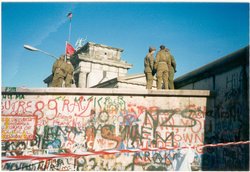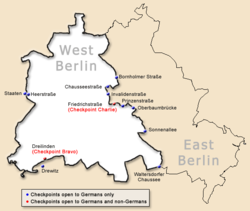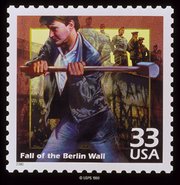Berlin Wall
|
|
The Berlin Wall (German: Berliner Mauer) was a long barrier separating West Berlin from East Berlin and the surrounding territory of East Germany. Its intent was to restrict access between West Berlin and East Germany. It was built in 1961 and fortified over the years, but was opened to unrestricted transit on November 9, 1989 and subsequently almost entirely demolished.
| Contents |
Background
Germany's capital, Berlin, was deep within the area which Allied war planners expected to be overrun by the Soviet army during the closing months of World War II. As the capital, the city was specially divided by the Allies into four sectors, one for each, although Berlin was completely surrounded on all sides by the Soviet sector of Germany. The Soviet Union, the United States, the United Kingdom, and France each had a portion of the city under their control. The Soviet sector was by far the largest and contained the traditional city center, Mitte, and the eastern districts of Berlin - Friedrichshain, K?ick, Lichtenberg, , Pankow, Prenzlauer Berg, Treptow, and Weiߥnsee.
The city was initially governed jointly by a commission of all four occupying armies, with leadership rotating on a monthly basis. As the early phases of the Cold War unfolded, tensions between the Soviets and the western allies escalated. Conflict over a currency reform in 1948 prompted the Berlin Blockade by the Soviet Union and led to the Berlin Airlift by the Western Allies. The Soviets lifted the ineffective blockade the next year.
After 1949, the three sectors controlled by the United States, Britain and France (West Berlin), although nominally still under joint four-power Allied sovereignty, were in effect an exclave of West Germany, completely surrounded by East Germany. West Berlin's precarious position was a key factor in the decision to make Bonn the capital of West Germany in preference to either West Berlin or Frankfurt.
Initially the citizens of Berlin were allowed to move freely among all the sectors. However, as the Cold War developed, movement became restricted. The border between East and West Germany proper was closed in 1952, and only in Berlin did the border remain open. The border between East and West Berlin was temporarily sealed on June 17, 1953 during the June 17 Uprising. Around 2.5 million East Germans crossed into the West between 1949 and 1961; after 1952 this happened almost exclusively via West Berlin. The majority of the professionally skilled workers were already leaving the east (for example, on one day the entire Mathematics Department of the University of Leipzig defected). Further, many West Berliners travelled into East Berlin to do their shopping at state-subsidized stores, where prices for foodstuffs were much lower than in West Berlin. This drain of labour and economic output threatened East Germany with economic collapse. This had ramifications for the whole Communist bloc and particularly the Soviet Union, because East Germany's economy was being subsidized by the Soviet government.
Construction of the Wall
The impetus for the creation of the Berlin Wall came from East German leader Walter Ulbricht, who sought the approval of Soviet leader Nikita Khrushchev for its construction. Khrushchev agreed, but imposed strict conditions. Ulbricht's proposal for a second air blockade was refused, and the construction of a barrier was permitted only if it were composed at first of barbed wire. If the Allies challenged the barbed-wire barrier, the East Germans were to fall back and were not to fire first under any circumstances.
Construction of the 28-mile barrier around the three western sectors began on Sunday August 13, 1961 in East Berlin. That morning, at midnight, the zonal boundary had been sealed by East German troops. The barrier was built by East German troops and workers, not directly involving the Soviets. It was built a little way inside East German territory to ensure that it did not encroach on West Berlin at any point; if one stood next to the West Berlin side of the barrier (and later the Wall), one was actually standing on East Berlin soil. The streets along which the barrier ran were torn up to make them impassable to most vehicles and a barbed-wire fence was erected, which was later built up into the full-scale Wall. It physically divided the city and completely surrounded West Berlin. During the construction of the Wall NVA and KdA soldiers stood in front of it with orders to shoot anyone who attempted to defect.
Germans on both sides were deeply distressed: many families were split, many East Berliners were cut off from their jobs and chances of a better life, and West Berlin became an isolated enclave in a hostile land. West Germans demonstrated against the wall, led by their mayor Willy Brandt, who strongly criticized the USA for failing to respond. Allied intelligence agencies had hypothesized about a wall to stop the flood of refugees but the main candidate for its location was around the perimeter of the city. Besides, America had been caught off-balance, it being a Sunday morning.
But John F. Kennedy had accepted in a speech [1] (http://www.jfklibrary.org/speeches.htm) on July 25 1961 that it could only really hope to defend West Berliners and West Germans: to attempt to stand up for East Germans would only result in an embarrassing climbdown. Accordingly, the administration made polite protests, at length, via "the usual channels", but without fervour, even though it was a violation of the postwar Four Powers Agreements, which gave the United Kingdom, France and the United States a say over the administration of the whole of Berlin. Indeed, a few months after the barbed wire went up, the US government would inform the Soviet government that it accepted the Wall as "a fact of international life" and would not challenge it by force.
But it was clear both that West German morale needed more and that there was a serious potential threat to the viability of West Berlin. And if West Berlin fell, after all the efforts of the Berlin Airlift, how could any of America's allies rely on her? On the other hand, in the face of any serious Soviet threat, an enclave like West Berlin could not be defended except with nuclear weapons. So it was vitally important for the Americans to show the Soviets that they could push their luck no further.
Accordingly General Lucius D. Clay, who was deeply respected by Berliners after commanding the American effort during the Berlin Airlift (1948-9) and was known to have a firm attitude towards the Soviets, was sent to Berlin with ambassadorial rank (as JFK's special advisor). He and Vice-President Lyndon B. Johnson arrived at Templehof airport on the afternoon of Saturday 19 August. They arrived in a city defended by what would soon be known as the "Berlin Brigade", which then consisted of the 2nd and 3rd Battle Groups of the 6th Infantry, with Company F, 40th Armor. The battle groups were pentomic, with 1362 officers and men each. On 16 August, Kennedy had given the order for them to be reinforced. Early on 19 August, the 1st Battle Group, 18th Infantry (commanded by Col Glover S. Johns Jr.) was alerted.
On Sunday morning, lead elements in a column of 491 vehicles and trailers carrying 1500 men, divided into five march units, left the Helmstedt-Marienborn checkpoint at 0634. At Marienborn, the Soviet checkpoint next to Helmstedt on the West German/East German border, US personnel were counted by guards. The column was 100 miles long, and covered 110 miles from Marienborn to Berlin in full battle gear, with VoPos (East German traffic police) watching from beside trees next to the autobahn all the way along. The front of the convoy arrived at the outskirts of Berlin just before noon, to be met by Clay and Johnson, before parading through the streets of Berlin to an adoring crowd. At 0400 on Monday 21 August, Lyndon Johnson left a visibly reassured West Berlin in the hands of Gen. Frederick O Hartel and his brigade, now of 4224 officers and men. Every three months for the next three and a half years, a new American battalion was rotated into West Berlin—by autobahn, to demonstrate Allied rights.
The East German government claimed that the Wall was an "antifascist protection barrier", intended to dissuade aggression from the West. However, this position was viewed with scepticism even in East Germany; its construction had caused considerable hardship to families divided by the Wall, and the Western view that the Wall was a means of preventing the citizens of East Germany from entering West Berlin and West Germany was widely seen as being closer to the truth.
Additionally, the whole length of the border between East and West Germany was closed with chain-fences, walls, minefields and other installations (see GDR border system).
How the Wall worked
The Wall was over 155 km (96 miles) long. In June 1962 work started on a second parallel fence up to 100 yards further in, with houses in between the fences torn down and their inhabitants relocated. An empty No Man's Land was created between the two barriers, which became widely known as the "death strip". It was paved with raked gravel, making it easy to spot footprints left by escapers; it offered no cover; it was mined and booby-trapped with tripwires; and, most importantly, it offered a clear field of fire to the watching guards.
Over the years, the Wall went through four distinct phases:
- Basic wire fence (1961)
- Improved wire fence (1962-1965)
- Concrete wall (1965-1975)
- Grenzmauer 75 (Border Wall 75) (1975)
The "fourth generation wall", known officially as "St?delement UL 12.11", was the final and most sophisticated version of the Wall. Begun in 1975, it was constructed from 45,000 separate sections of reinforced concrete, each 3.6m high and 1.5m wide, and cost 16,155,000 East German Marks. The top of the wall was lined with a smooth pipe, intended to make it more difficult for escapers to scale it. It was reinforced by mesh fencing, signal fencing, anti-vehicle trenches, barbed wire, over 300 watchtowers, and thirty bunkers. This version of the Wall is the one most commonly seen in photographs, and surviving fragments of Wall in Berlin and elsewhere around the world are generally pieces of the fourth-generation Wall.
Although Allied military personnel, officials and diplomats were still able to pass into East Berlin following the construction of the Wall — free passage of such people was a requirement of the post-war Four Powers Agreements — the West Berliners were initially subject to very severe restrictions. All of the crossing points were closed to West Berliners between August 26, 1961 and December 17, 1963, and it was not until September 1971 that travel restrictions were eased following a Four Powers Agreement on transit issues. Passage in and out of West Berlin was limited to a total of twelve crossing points on the Wall, though all but two of these were reserved for Germans. The only land route into Berlin that was accessible to Westerners was via the Berlin-Helmstadt autobahn, which entered Berlin at Dreilinden in south-western Berlin and crossed East German territory to reach the town of Helmstadt on the West Germany/East Germany border. A crossing at Friedrichstraߥ in central Berlin gave Westerners their only access between West and East Berlin.
The three crossing points were named phonetically: Alpha (Helmstadt), Bravo (Dreilinden), and, most famously, Checkpoint Charlie (Friedrichstraߥ).
The Years of the Wall
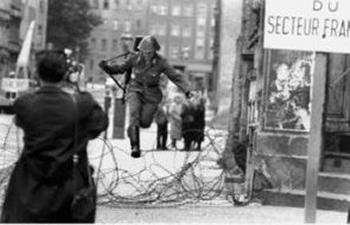
During the Wall's existence there were around 5,000 successful escapes into West Berlin; 192 people were killed trying to cross and around 200 were seriously injured. Early successful escapes involved people jumping the initial barbed wire or leaping out of apartment windows along the line. These quickly ended. Other successful escape attempts included 57 people who escaped through a 145 metre long (475 feet) tunnel dug by West Berliners, on October 3, 4 and 5, 1964; and two escapes made by sliding along aerial runways (one by two men, one by a family). One man drove a very low sports car underneath a barricade at Checkpoint Charlie. One of the last escapes occurred when two men flew fixed wing ultralights across the Wall to rescue their brother.
The most notorious failed attempt was by Peter Fechter who was shot and left to bleed to death in full view of the western media, on August 17 1962. The last person to be shot trying to cross the border was Chris Gueffroy on February 6, 1989.
Foreigners frequently and legally crossed the Wall, and the East Germans welcomed their money. They were of course always subject to careful checks both entering and leaving. When exiting a typical tactic was for the police to run a mirror under each vehicle to look for persons clinging to the undercarriage. East Germans were occasionally given permission to cross, particularly when they were too old to work. Sometimes political prisoners were dramatically released--for a price--at one of the checkpoints. At the border section in Potsdam U-2 pilot Gary Powers was traded for Russian spy Rudolf Abel.
In books and movies Checkpoint Charlie and the Wall in general became the scene of various political thrillers. During several tense standoffs, particularly during the Berlin Crisis and the Cuban Missile Crisis it was feared that World War III would begin here.
The creation of the Wall had important implications for both Germanies. By stemming the exodus of people from East Germany, the government of the GDR was able to reassert its control over the country. However, the Wall was a propaganda disaster for East Germany and for the communist bloc as a whole. It became a key symbol of what Western powers regarded as Communist tyranny, particularly after the high-profile shootings of would-be defectors (which were later treated as acts of murder by the reunified Germany). In 1987, Ronald Reagan gave a famous speech at the Brandenburg Gate, at which he challenged Mikhail Gorbachev to "tear down this wall". In West Germany, dismay that the Western powers had done nothing to prevent the Wall's creation led directly to the policy of Ostpolitik or rapprochement with the east, in an effort to stabilise the relationship of the two Germanies.
The Fall of the Wall
On August 23, 1989, Hungary removed its border restrictions with Austria, and in September more than 13,000 East Germans escaped through Hungary. Mass demonstrations against the government in East Germany began in the fall of 1989. The leader of East Germany, Erich Honecker, resigned on October 18, 1989. He was replaced by a short-lived successor, Egon Krenz, a few days later.
The new Krenz government decided to allow East Berliners to apply for visas to travel to West Berlin on November 9, 1989. Due to a misunderstanding, G?Schabowski announced in a live press conference shown on East German state TV that all travel restrictions had been abandoned. Tens of thousands of people immediately went to the checkpoints in the Wall and demanded entry into West Berlin. They quickly became a major crowd control problem for the surprised and overwhelmed border guards. Many hectic telephone calls with the guards' superiors ensued while still more people kept converging on the major crossing points. It became clear that there was no way to hold back the huge crowd of East German citizens short of dispatching the army to kill them all, as the vastly outnumbered border guards had only been equipped for another day of regular duty. The masses could also not be convinced to turn back or calm down — they had heard of Mr. Schabowski's statement, and they wanted it to be acted upon. The only way to hold the crowds back would have been through the use of massive lethal force, but this would have meant massacring the country's own citizens in huge numbers — which the guards and authorities were simply not willing to do. In face of the escalating crowd safety situation, the guards eventually just yielded, opening the access points and allowing people through with (at most) minimal identity verification checks. The ecstatic East Berliners were soon greeted by jubilant West Berliners on the other side in a celebratory, party atmosphere. November 9 is thus considered the date the Wall fell. In the days and weeks that followed, people began arriving at the wall with sledgehammers and physically demolishing it, section by section..
Berlin-wall-dancing.jpg
Celebrations
On Christmas Day, December 25, 1989 Leonard Bernstein gave a concert in Berlin celebrating the end of the Wall, including Beethoven's 9th symphony (Ode to Joy) with the chorus' word "Joy" (freude) changed to "Freedom" (freiheit). Roger Waters performed the Pink Floyd concert The Wall in Potsdamer Platz on 21 July 1990, with guests including The Scorpions, Bryan Adams, and Van Morrison.
The fall of the wall was the first step to the reunification of Germany, which was formally concluded on October 3, 1990.
Some believe November 9, which marks the emotional apogee of East Germany's peaceful revolution, would have made a good German National Holiday. This is reinforced by the fact that November 9 was also the date of the declaration of the first German republic, the Weimar Republic, in 1918. However, because November 9 is also the anniversary of the infamous Kristallnacht pogroms of 1938, the October 3 date was chosen instead. (Another reason given for the October 3 date of reunification is that the West German government wanted to conclude reunification before East Germany could celebrate a 41st "birthday," on October 7 1990.)
Aftermath
The fall of the wall considerably changed traffic patterns in the city, and the M-Bahn, a maglev system connecting 3 metro stations over 1.6 km, was demolished just months after its official opening in July 1991 as its track area was desperately needed for new East-West connections.
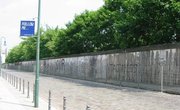
Little is left of the Wall in Berlin today. The Wall was physically destroyed almost everywhere, except for three locations: one section of 80m near Potsdamer Platz (see picture), a second longer one along the Spree River near the [[Oberbaumbr?, the so-called East Side Gallery, and a third one in the north at Bernauer Straߥ, which was turned into a memorial in 1999. Even the parts that are left standing no longer accurately represent the Wall's original appearance: they are badly damaged (since so many people attempted to pick up "original Berlin Wall" pieces), and today graffiti is prevalent on the eastern side of the Wall, which obviously would not have been possible while the Wall was actually guarded by heavily armed soldiers of East Germany. Previously, graffiti was exclusively on the western side.
For some years after reunification there was much talk in Germany of continuing cultural differences between East and West Germans (colloquially Ossis and Wessis), sometimes described as "the Wall in people's heads". A September 2004 poll found that 25% of West Germans and 12% of East Germans wished that East Germans were again cut off from West Germany by the Berlin Wall. [2] (http://www.msnbc.msn.com/id/5942091/) Many German public figures have called these numbers "alarming".
Fifteen years after the fall of the Berlin Wall, a private museum is rebuilding a 200-meter section close to Checkpoint Charlie. [3] (http://www.msnbc.msn.com/id/6206555/)
See also
References
- William F. Buckley, Jr.. The Fall of the Berlin Wall. Hoboken, New Jersey: John Wiley and Sons, 2004. ISBN 0471267364. (A concise, very readable account of the history of the wall.)
- Curtis Cate. The Ides of August: The Berlin Wall Crisis--1961. New York City: M. Evans, 1978.
- Honor頍. Catudal. Kennedy and the Berlin Wall Crisis. West Berlin: Berlin Verlag, 1980.
- John F. Kennedy. July 25, 1961 speech (http://www.jfklibrary.org/speeches.htm)
- Peter Wyden. Wall: The Inside Story of Divided Berlin. New York City: Simon and Schuster, 1989.
External links
- Berlin Wall - Pictures Photographs (http://www.dieberlinermauer.de/berlinwallhome/berlinwallhome.html)
- www.wall-berlin.org
- Personal Account of the Fall of the Berlin Wall (http://www.andreas.com/berlin.html)
- Retracing the Berlin Wall (http://www.die-berliner-mauer.de/en/index.html)
- Bernauer Straߥ Memorial website (http://www.berliner-mauer-dokumentationszentrum.de/)
- Berlin Photos 1989-1999 (http://www.geocities.com/isanders_2000/)
- Information on the East German border system (in German) (http://www.passkontrolle-ddr.de)
- Berlin Wall photos and stories 1989 (http://www.berlin-wall.net/)
- Photographs of time of the Fall as well as updates on the current situation in Germany (http://www.guardian.co.uk/wall/)
- www.dewitt.photographer.org.uk, images of the Berlin wall
- Berlin Wall Online (http://www.dailysoft.com/berlinwall/), Chronicle of the Berlin Wall history includes an archive of photographs and texts
- Photos of the Berlin Wall by Igor Schestkow, 2004 (http://www.igor-schestkow.de/en/photos)
- Reports on reinforcements to Berlin Brigade (http://www.theberlinobserver.com/1stBG18thinf.html)
- JFK speech clarifying limits of American protection (http://www.jfklibrary.org/jfk_berlin_crisis_speech.html)
- US Army website (http://www.usarmygermany.com/Units/Berlin%20Brigade/USAREUR_Berlin%20Brigade.htm)

